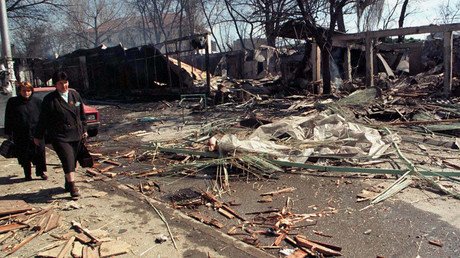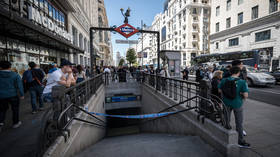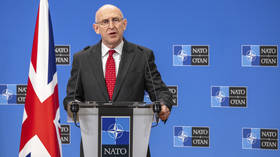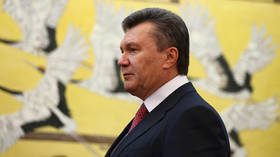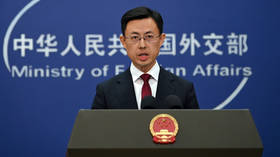Kangaroo court convicts Karadzic

By convicting Bosnian Serb leader Radovan Karadzic of genocide and crimes against humanity, the war crimes tribunal in The Hague is not bringing peace, reconciliation or closure – but a cynical victor’s justice, an endorsement of ‘might makes right.’
According to the International Criminal Tribunal for the former Yugoslavia (ICTY), Karadzic was found guilty of ten out of eleven counts of the original indictment, including the so-called “genocide” of an estimated 8,000 Muslims in Srebrenica and the “joint criminal enterprise” to create an ethnically pure “Greater Serbia” on the ruins of Yugoslavia.
READ MORE: Bosnian Serb leader Karadzic responsible for 'Srebrenica genocide', sentenced to 40 years
Thursday’s verdict surprised precisely no one. The ICTY was pretty much created to prosecute Karadzic – or rather, the complete Serb political and military leadership during the Wars of Yugoslav Succession in the 1990s. The very purpose of the ad-hoc tribunal, a brainchild of the Clinton administration’s “human rights interventionists,” was to deny any legal legitimacy to the Serbs, while bestowing it on the US and its regional clients and proxies.
While Germany was the principal outside backer of the governments in Slovenia and Croatia when they sought to secede from Yugoslavia in 1991, by the following year that role was taken over by Washington. Embracing the narrative of “democratic” Slovenes, Croats and others waging the righteous fight against “Communist Serbian aggression,” the US backed the Muslims in Bosnia in reneging on the power-sharing agreement with the republic’s Christian majority.
Both Serbs and Croats took up arms in response. By 1994, however, the US had midwifed an alliance between the Croats and Muslims, and later arranged for the Serb leadership – civilian president Radovan Karadzic and military commander Ratko Mladic – to be indicted for genocide and war crimes.
A major feature of US intervention in the Balkans was the way in which it bypassed, co-opted or sidelined the United Nations. While insinuating NATO into the UN mission until it finally took over, Washington systematically torpedoed peace talks until it could hijack the process with a self-appointed “contact group” and stage the end of the Bosnian War in Dayton, Ohio in 1995.
The Dayton miracle: Bosnia armistice, still alive at 20 (Op-Edge) https://t.co/nlH7ykhrizpic.twitter.com/ZVEHSOaCkQ
— RT (@RT_com) November 21, 2015
One key element in the process was the US-inspired creation of the ad-hoc tribunal in May 1993. Yes, it was established by the UN Security Council, in Resolution 827. However, the Security Council claimed to act under Chapter VII of the UN Charter, allowing the creation of “measures to maintain or restore international peace and security.” The very inception of the ICTY required stretching the definition of “measures” to include judicial power the UNSC clearly lacked – and therefore could not delegate.
Even if the tribunal were perfectly legitimate to begin with, its pattern of indictments should have been a signal something was amiss. The ICTY and its backers clearly believed any Serb atrocities were systematic and deliberate, while those committed by anyone else were random or incidental. While every single senior Serb official in present-day Croatia, Bosnia and Serbia was hauled before the court, only a few lower-level Croat, Bosnian Muslim or Albanian officials were even indicted – and most of them were acquitted outright, or on appeal. Only Serbs were charged with genocide – by definition, a systematic crime. Only Serbs were accused of a "joint criminal enterprise," a category specifically constructed for the tribunal by a US jurist.
On May 27, 1999, two months into the illegal NATO war against Yugoslavia, the Tribunal indicted Yugoslav president Slobodan Milosevic for war crimes and genocide. In July that year, the very same tribunal decided NATO’s declaration it was not guilty of anything was good enough, and merited no further investigation.
“NATO countries are those that have provided the finance to set up the Tribunal, we are amongst the majority financiers… so let me assure that we and the Tribunal are all one on this, we want to see war criminals brought to justice and I am certain that when Justice Arbour goes to Kosovo and looks at the facts she will be indicting people of Yugoslav nationality and I don't anticipate any others at this stage,” NATO spokesman Jamie Shea told reporters on May 17, 1999. Telling enough?
Milosevic was arrested in 2001 by a government installed in a US-backed coup, which sent him to The Hague via extrajudicial rendition. He died in March 2006, under mysterious circumstances, before the trial could be concluded.
On July 11, 2013 – a date deliberately chosen to coincide with the alleged “genocide” in Srebrenica – the ICTY rejected Karadzic’s motion to dismiss the charges. Among the “evidence” cited by US judge Theodor Meron was a hearsay claim that Karadzic had decided “in the early 1990s” to kill a third of the Muslims, convert a third to Orthodoxy, while the rest would leave on their own.
While such a plan did exist, it was the brainchild of the WW2 Nazi-allied Croatian government, and its intended targets were Serbs living in present-day Croatia and Bosnia-Herzegovina. The ICTY was accusing the Serbs of doing what was actually done to them 70 years prior – and when Karadzic tried to argue the point, the prosecutors dismissed WW2 as ancient history.
Wednesday’s revelation by Peter Robinson, Karadzic’s legal adviser, that the prosecution chose to share 200-plus pages of exculpatory evidence less than 24 hours before the verdict, is the perfect illustration of how the Tribunal has mocked the rules of due process.
Just rec'd 208 pages of exculpatory material in #Karadzic case from #ICTY prosecution this afternoon. Seriously, prosecutors?
— Peter Robinson (@PeterRobinICTY) March 23, 2016
Ironically, the one count on which Karadzic was acquitted demonstrates that the black-robed enablers of “bombs for peace” can’t stomach some of their own nonsense. They ruled that atrocities in seven municipalities did not quite rise to the level of genocide, as they could find no proof of intent. Yet they continued to maintain that what allegedly happened in Srebrenica in 1995 met the definition – because they had to, as “Srebrenica” has become the universal excuse for “humanitarian” mass murder.
READ MORE: How Srebrenica tragedy became excuse for atrocities around the world
“The falseness of the entire situation here defies description,” Karadzic said in his opening defense statement. Thursday, he was proven right.
Nebojsa Malic for RT
The statements, views and opinions expressed in this column are solely those of the author and do not necessarily represent those of RT.
